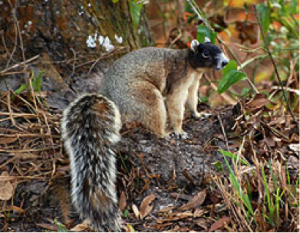By Kevin Kloda, Masters student, Wildlife Ecology & Conservation
How do you manage for a species you know little about? Aldo Leopold, arguably one of the most influential wildlife conservationists, wrote about the law of the limiting link, or the characteristic we know the least about. Leopold argues that we can only manage wildlife by understanding each of a species’ vital characteristics. For wildlife managers in Florida, fox squirrels have many limiting links because we know so little about them.
The species is protected from hunting and two of the four subspecies, Sherman’s Fox Squirrel and the Big Cyprus Fox Squirrel, are listed as threatened. Previous research suggests that fox squirrels rely on longleaf pine savannahs, open canopy forests with sparse understory. Unfortunately, longleaf pine forests are disappearing and research suggests that fox squirrel populations are too. A complicating factor in fox squirrel research is that they are challenging to detect. Low detection rates make it difficult to estimate how many squirrels are out there and what types of habitat they use.
Dan Greene, a PhD student in the Department of Wildlife Ecology and Conservation, set out to determine the best method for fox squirrel detection and to quantify the habitats that they use.

How should we survey fox squirrels?
Greene tested 4 methods for squirrel detection; camera traps, live traps, 20 minute stationary visual surveys, and walking visual surveys. Camera traps were overwhelmingly more successful than the alternatives. Individual squirrels were identified in camera trap photos using variations in fur coloration. Live traps produced much lower detection rates and Dan’s team only detected a handful of squirrels using stationary visual surveys. These squirrels hide by lying flat and motionless on a branch to avoid predation. If you walked the area to see if there were any of these squirrels, the squirrels would likely detect you first and hide.
Greene also did a cost benefit analysis of the detection methods to determine which method was the most economical. Cameras were expensive, but unlike the labor costs associated with the other survey methods, cameras can be used repeatedly and on future research projects. Moreover, cameras detected so many squirrels that the cost per detection was much lower than any of the other methods. It was clear that camera trapping was the best method for detecting fox squirrels.
What does this mean for managers? Camera trapping is a more effective way to determine fox squirrel abundance in order to assess whether populations are declining.
What kind of habitat do fox squirrels prefer?
In order to determine the types of habitats that fox squirrels use, Greene set up camera traps in locations that varied in topography and land cover. Forty total study areas were used with ten chosen for being within the favorite habitats of the Sherman’s fox squirrel and ten chosen as the favorite of Big Cyprus fox squirrels. The remaining twenty were chosen at random. The study areas ranged from dense forest cover to no forest cover and from mangrove forest to pine savannah.
Greene’s cameras took almost 1 million photos and captured thousands of pictures of fox squirrels. Greene found that many of the fox squirrel subspecies, including Sherman’s and Big Cyprus, occur in the longleaf pine savannah landscape, but can live in other open canopy habitats, such as golf courses. Fox squirrels may use sparse forests because they provide a unique combination of benefits to the squirrels. The openness of the vegetation allows for visual predator detection and supplies ample food resources while the closed-canopy areas provide nest sites and cover from predators. Alternatively, they may use these areas because grey squirrels out-compete fox squirrels in denser, closed-canopy forests.
Why is this research important?
Fox squirrels are a game species in many states and hunting is big business. Purely from an economic standpoint, ensuring a viable hunting population means more money for the state of Florida. From an ecological standpoint, fox squirrels are seed dispersers and efficient ones at that. There are thousands of trees that sprouted because of fox squirrels burying their seeds. Certain species of fungi also rely on fox squirrels for spore dispersal. These squirrels are also a food source for animals like bobcats and hawks. The biological value of fox squirrels is high and must be maintained to ensure a healthy and prosperous ecosystem.
What can be done to improve fox squirrel conservation and management?
Managers should first determine the abundance of squirrels in an area and determine what action should be taken. To increase the population the habitat must be changed to better suit the squirrels. Burning and timber practices, such as thinning the understory or roller chopping, enhance the habitat not only for these squirrels but for some game species as well. Disturbances such as these keep the understory from growing too thick for the squirrels to easily move and evade predation. Fox squirrels have been known to leave areas where the understory has grown too thick. Many private landowners prefer the longleaf pine system because it suits some game species and there are federal subsidies for planting the longleaf pine because it is an endangered species of tree. What else can be done? With Greene’s new methodology for capturing the fox squirrel, more research can be done to study other issues facing the species, such as the impact of habitat loss and fragmentation on fox squirrel abundance.

Dan Greene completed his B.A. at Earlham College and M.S. at the University of Georgia studying the population dynamics of Key Largo cotton mice. After working for Florida Wildlife Commission for a while, he decided to go back to school and earn his Ph.D. at UF under the advisement of Dr. Bob McCleery. He was awarded the 1st Courtney A. Tye Memorial Graduate Student Scholarship from the Florida chapter of the Wildlife Society. He has shown a great interest in small mammals and endangered species and aspires to continue to research ways to aid in conservation of imperiled species.
 1
1
